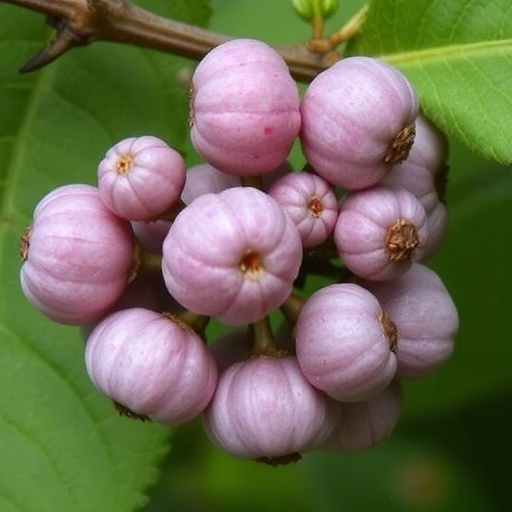In a groundbreaking study published in the journal “Discover Agriculture,” researchers have uncovered a novel method for the management of mealybugs in mulberry crops through the use of fungal enzymes to bioscour mealybug wax. This environmentally friendly approach not only offers a sustainable alternative to conventional pest control methods but also highlights the potential of microbial genetics in agricultural practices. The mealybug, an insidious pest notorious for causing severe damage to mulberry plants, has long posed a challenge for farmers and researchers alike.
The research team, led by Y. Nagaraju and including collaborators S. Kikon and R. Reshma, embarked on their investigation recognizing the pressing need for sustainable agricultural practices. Traditional methods of pest control often rely on chemical insecticides, which, while effective, come with adverse effects on the environment and ecosystems. The study aims to shine a light on an eco-friendly solution that utilizes naturally occurring fungal enzymes to efficiently break down mealybug wax, thereby rendering these pests more susceptible to natural predators and other pest control methods.
The team set out to isolate specific fungal strains known for their enzyme production capabilities, specifically targeting those that can break down complex wax structures. These waxes are a critical component of the mealybug’s defense system, aiding in their survival and resilience against environmental stressors. By employing advanced biotechnology techniques, the researchers succeeded in identifying several strains of fungi that could be used in the bioscouring process. The enzymes produced by these fungi have shown exceptional efficiency in degrading the wax, thus revealing the intricate relationship between microbes and pest management.
One of the standout findings from the research was the remarkable effectiveness of these fungal enzymes in degrading mealybug wax. Laboratory experiments indicated that the application of these enzymes increased the mortality rate of mealybugs significantly when compared to untreated populations. This observation suggests that the enzyme treatment could serve as a viable pest management strategy, potentially reducing the need for synthetic pesticides that can lead to harmful chemical residues in crops.
Furthermore, the team conducted field trials to assess the practical applications of their findings in real-world agricultural settings. By incorporating the fungal enzymes into integrated pest management systems, farmers could achieve better control of mealybug populations while simultaneously promoting a healthier ecosystem. The researchers emphasized that this method could lead to a sustainable agricultural practice that not only protects crops but also aligns with global efforts to reduce chemical inputs in farming.
The implications of this study extend beyond mulberry cultivation. The potential for applying similar strategies to other crops affected by mealybugs and related pests is enormous. By understanding the enzymatic properties of these fungi, there is a chance to develop a broader range of biocontrol agents tailored to various agricultural challenges. This research opens the door to a paradigm shift in pest management, one that fosters an organic approach while ensuring crop health and yield.
Moreover, the ecological footprint of traditional pest control measures is a significant concern for the agricultural sector. The adverse environmental impacts stemming from chemical pesticide use can have lasting consequences, not only for target pests but also for beneficial organisms and the wider ecosystem. The findings from Nagaraju and colleagues highlight the importance of exploring alternative, biology-based solutions that can mitigate these issues effectively.
In conclusion, the bioscouring of mealybug wax using fungal enzymes presents an innovative framework for sustainable agricultural practices. The findings of this study underscore the importance of continued research into microbial solutions that can aid in the management of pests while promoting ecological balance. As the agricultural community increasingly seeks methods to reduce reliance on chemical inputs, this research serves as a promising step towards a more sustainable future for crop production.
In summarizing the significance of this research, it becomes clear that the innovative approach taken by the authors is not merely a scientific curiosity but a necessary evolution in how we consider pest management. Their efforts are commendable and represent the kind of forward-thinking required to address the multifaceted challenges facing contemporary agriculture.
Through the integration of biotechnology and sustainable practices, the potential for reshaping agricultural landscapes becomes a reality. The scientific community and farming industry are poised to benefit from these findings, paving the way for enhanced crop resilience and reduced ecological impact. Future research will undoubtedly build upon this foundational work, further exploring the capabilities of various microbial enzymes and their application across different agricultural systems.
As we look to the future of pest management and crop sustainability, the innovative work presented by Nagaraju and his team serves as a beacon of hope. With the ongoing challenges posed by climate change and the need for more resilient farming practices, their research brings us one step closer to a harmonious balance between agriculture and nature.
Subject of Research: Bioscouring of mealybug wax using fungal enzymes for sustainable management of mealybugs in mulberry crops.
Article Title: Bioscouring of mealybug wax using fungal enzymes for sustainable management of mealybugs in mulberry.
Article References:
Nagaraju, Y., Kikon, S., Reshma, R. et al. Bioscouring of mealybug wax using fungal enzymes for sustainable management of mealybugs in mulberry. Discov Agric 3, 219 (2025). https://doi.org/10.1007/s44279-025-00341-1
Image Credits: AI Generated
DOI: 10.1007/s44279-025-00341-1
Keywords: Mealybug management, fungal enzymes, bioscouring, sustainable agriculture, mulberry cultivation.




